Mining Area of the Great Copper Mountain in Falun: The Great Copper Mountain was a copper mine in Falun, Sweden. The Great Copper Mountain operated from the 9th century until 1992. In the 17th century, it became the major producer of copper in the world. A by-product of the Great Copper Mountain in Falun are the natural pigments used for coloring the Falu Red Paint, the traditional deep red paint well known for its use on wooden cottages and barns. The Falu Red Paint is still popular in Sweden, Norway and Finland. In Finland, the paint is known as the 'punamulta' (Red Earth). The Great Pit (Swedish: Stora Stöten) is the result of a major mine cave-in in 1687. In 1719, miners of the Great Copper Mountain in Falun found a completely intact dead man. Fet Mats Israelsson died 42 years earlier when a part of the Falun Copper Mine caved-in, copper sulphate had perfectly preserved his body. Nowadays, the buildings of the mine company houses the Mine Museum in Falun. 'Anfarten' is the former mine entrance. Nowadays, 'Anfarten' is the entrance to the visitors mine of the Great Copper Mountain in Falun. Many members of the Swedish Royal Family visited the Falun Copper Mine, the royal visitors have written their names on the wall of the Christmas Gift Chamber. The Great Copper Mountain in Falun is located along the Winter Route. The Winter Route formed a network across Norway and Sweden, linking the mines to the main roads. Hundreds of years ago there were no railways or cars. In winter, people used sleighs to transport the goods. The Winter Route was used from November to May. The Mining Area of the Great Copper Mountain in Falun became a UNESCO World Heritage in 2001. World Heritage Art: Chess Set Fet Mats
www.werelderfgoedfotos.nl © Copyright World Heritage Photos
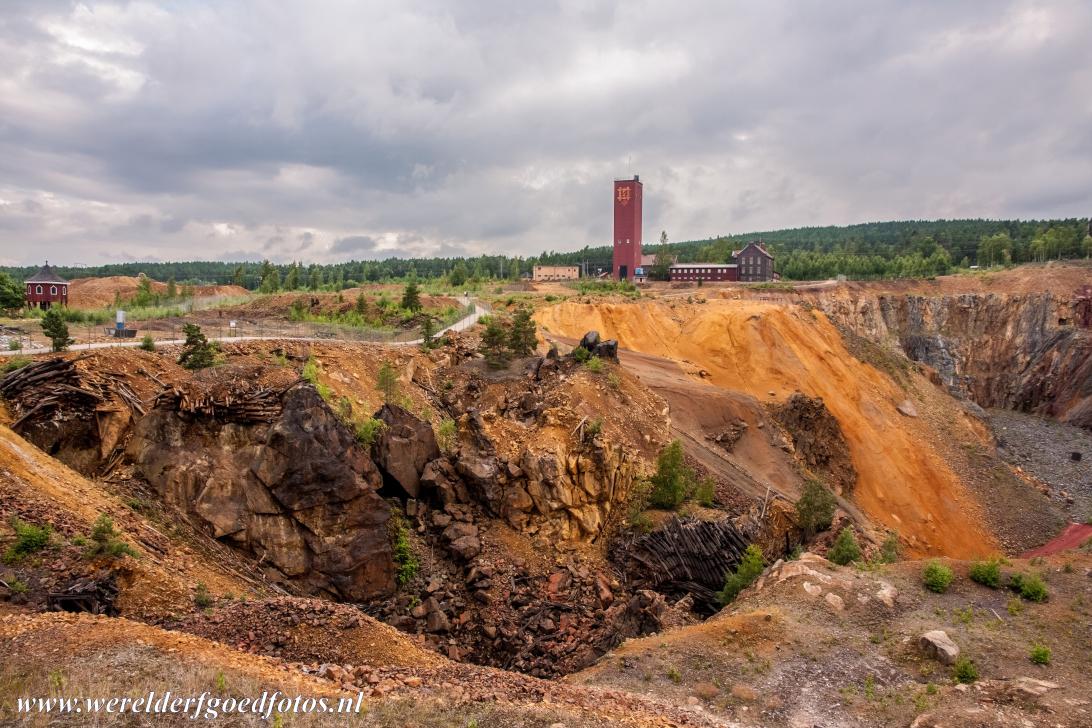
Mining Area of the Great Copper Mountain in Falun: Stora Stöten, the Great Pit, was caused by cave-in. The Great Copper Mountain was a copper mine in Falun, a town in Sweden. The copper mine operated from the 9th century until 1992. In the 17th century, the Great Copper Mountain in Falun became the most important producer of copper in the world. The Mining Area of the Great Copper Mountain in Falun gained the status as a UNESCO World Heritage in 2001.

Mining Area of the Great Copper Mountain in Falun: Stora Stöten, the Great Pit, was caused by cave-in. The Great Copper Mountain was a copper mine in Falun, a town in Sweden. The copper mine operated from the 9th century until 1992. In the 17th century, the Great Copper Mountain in Falun became the most important producer of copper in the world. The Mining Area of the Great Copper Mountain in Falun gained the status as a UNESCO World Heritage in 2001.
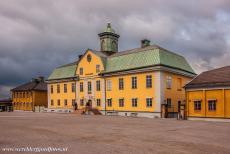
UNESCO World Heritage Site Mining Area of the Great Copper Mountain in Falun: Nowadays, the buildings of the mine company houses the Falun Mine Museum. In the 17th century, the Great Copper Mountain produced two thirds of the needs of copper in Europe. In the 17th century, the Great Copper Mountain was the treasury of Sweden, the riches extracted from the ground here paid the various wars of Sweden in the 17th century.
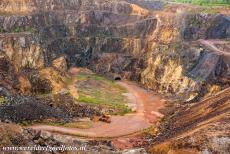
Mining Area of the Great Copper Mountain in Falun: The Great Pit is the result of a major cave-in in 1687, it occurred on Midsummer's Day, a traditional Swedish feast day, the miners were free from work, there were no casualties. The Great Copper Mountain in Falun was once the biggest copper mine in Europe and the largest industrial location in Sweden. Sweden had an inarguable monopoly on copper in the European market which it retained throughout the 17th century.
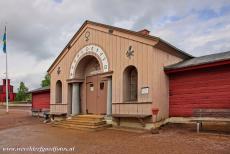
Mining Area of the Great Copper Mountain in Falun: The 'Anfarten' is the old mine entrance, it was built in 1812. The wooden building is situated above the shafts going into the copper mine. The 'Anfarten' is decorated with several mining symbols. Inside the building was a fireplace with an always burning fire, here the miners could light their torches before they went down to work in the Great Copper Mountain. Nowadays, the building is the entrance to the visitors mine.
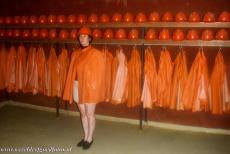
Mining Area of the Great Copper Mountain in Falun: The Falun Copper Mine can only be visited by guided tour. It is required to wear a helmet and cape. The helmets and capes are available on loan. A lift takes visitors down to a depth of 55 metres and the tour guide will lead them through the shafts and the chambers, such as the Creutz Shaft and the Christmas Gift Chamber. By an ancient tradition all shafts and chambers of a mine have a name of their own.
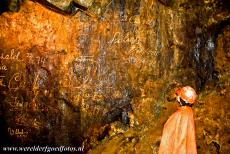
Falun Great Copper Mountain: The signatures of the Royal family of Sweden on the wall of the Christmas Gift Chamber, 'Julklappen'. Almost all Swedish monarchs have visited the Falun Great Copper Mountain. Royal visitors have inscribed their names on the wall of 'Julklappen', since the end of the 19th century, the Christmas Gift Chamber has served as a kind of 'guest book'. The Christmas Gift Chamber was so named because ore was found here at Christmas time.
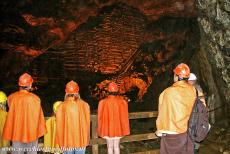
Mining Area of the Great Copper Mountain in Falun: The Creutz Schakt, the Creutz Shaft, is a 208 metres deep pit shaft. The Creutz Shaft was opened in 1662 and was finished in 1780. The Creutz shaft was crucial for the ventilation of the lower parts of the Great Copper Mountain in Falun. The Creutz shaft has been shut down in the beginning of the 20th century. Since 1969, some of the oldest part of the copper mine are open to visitors.
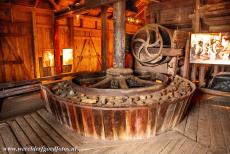
Great Copper Mountain in Falun: Around each rotating table sat boys aged ten to twelve, picking out the heavier shining ore and brushing the waste rock to one side. Each of the boys had a box into which he put the ore. Payment depended on the number of boxes the boy filled. For a full box payment was two öre around 1900. The Great Copper Mountain in Falun was shut down in December 1992. Nowadays, the copper mine is a museum.
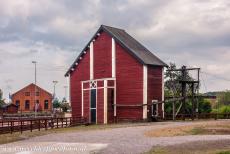
Great Copper Mountain in Falun: The Creutz Waterwheel House is situated close to the Creutz Shaft Head building. In the 17th century, the Great Copper Mountain in Falun reached its peak with an output of more than three thousand tons of raw copper and the Great Copper became the major producer of copper in the world. The wooden buildings of the Great Copper Mountain are painted with Falu-red paint, the traditional Swedish dark red paint.
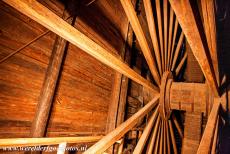
Mining Area of the Great Copper Mountain in Falun: The enormous Creutz Water Wheel was responsible for removing water from the copper mine. The Creutz Water Wheel was erected in 1845, the diameter of the wooden water wheel was nearly fifteen metres. The mechanism of the Creutz Water Wheel was in service until 1916. The Mining Area of the Great Copper Mountain in Falun was inscribed on the UNESCO World Heritage List in 2001.
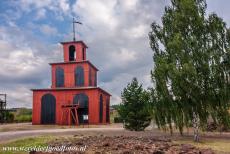
Mining Area Great Copper Mountain in Falun: The Creutz Shaft Head building was constructed in 1852 to protect the water pumps and hoisting equipment from rain, snow and ice. The Creutz Shaft Head was closed in the beginning of the 20th century when the new Oscar Shaft Head had been erected. The Mining Area Great Copper Mountain in Falun gained the status as a UNESCO World Heritage 2001.
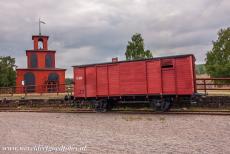
Mining Area of the Great Copper Mountain in Falun: In the background the Creutz Shaft Head. The Great Copper Mountain is located along the Winter Route, a road network across Norway and Sweden, linking the mines to the main roads. For a long time, the copper and goods could only be transported by horses and sleighs in winter. The birth of the steam locomotive and the railway networks in the 19th century made it much easier to transport the copper.
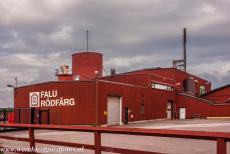
Mining Area of the Great Copper Mountain in Falun: The Falu Rödfärg Factory. A by-product of the Great Copper Mountain in Falun are the natural pigments used for colouring Falu Rödfärg, Falu Red Paint. Falu Rödfärg became popular because it was cheap. Now, it is very fashionable and no longer cheap. The Falu Rödfärg is part of the heritage of Sweden and still very popular in Sweden, Norway and Finland. The Great Copper Mountain is a UNESCO World Heritage.
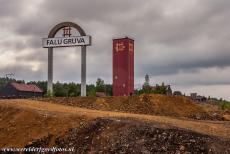
Mining Area of the Great Copper Mountain in Falun: The Oscars shaft tower was erected in the beginning of the 20th century. In 1719, the miners of Falun Copper Mine found an intact dead body in a disused part of the mine. Fet Mats Israelsson died 42 years earlier when a part of the Falun Copper Mine caved-in, copper sulphate had perfectly preserved his body. His bride-to-be Margareta Olsdotter, now a woman in her sixties, immediately recognized him.
